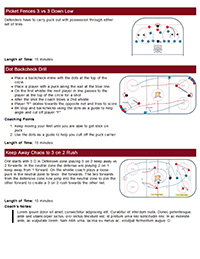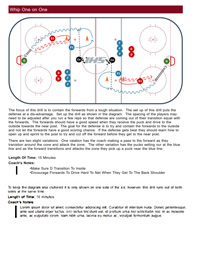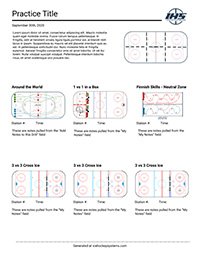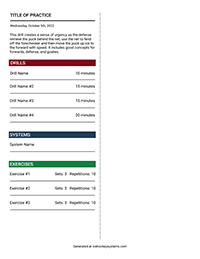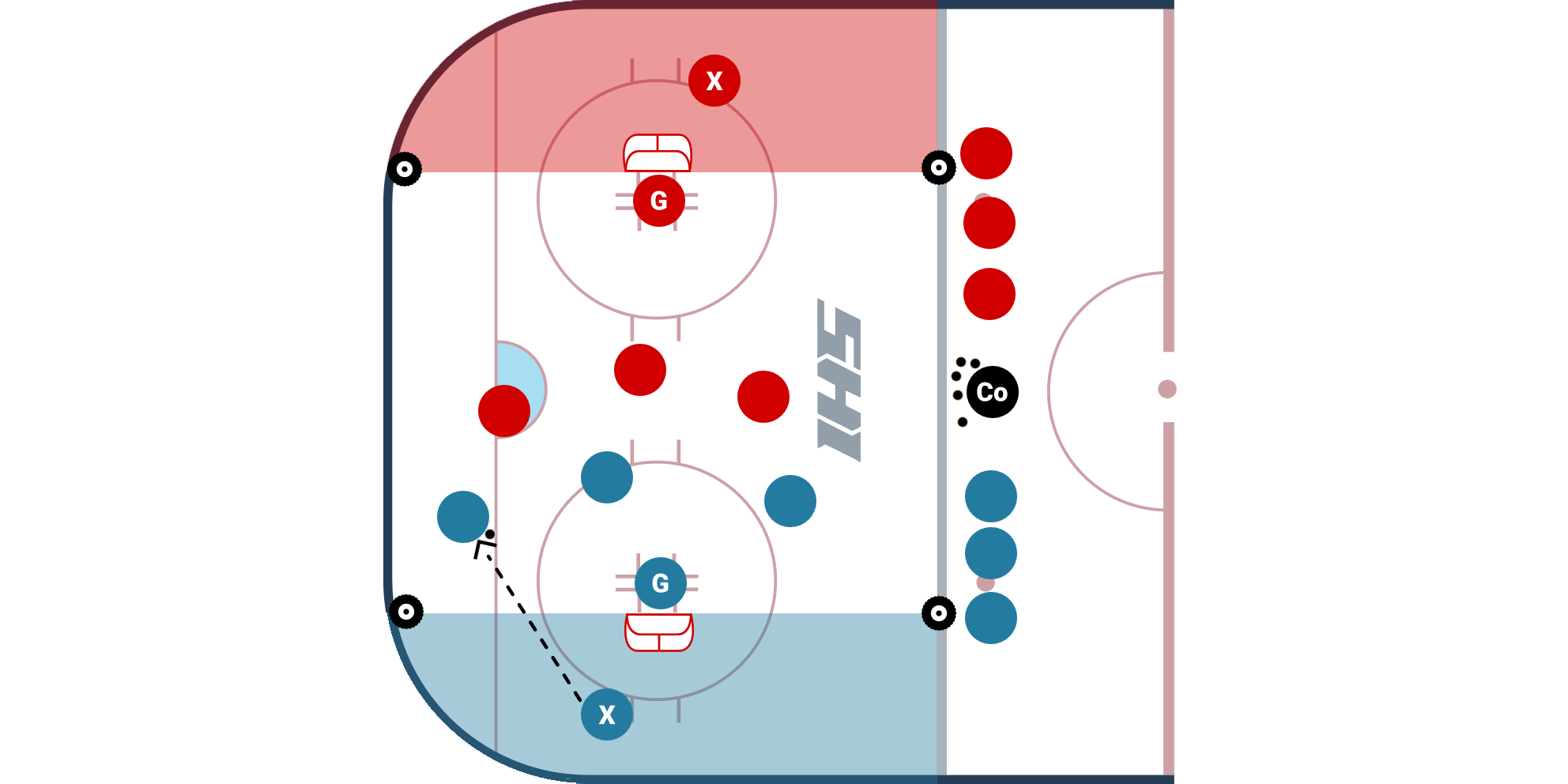
U12 to U14 Breakout Practice - Half Ice
U12 to U14 Breakout Practice - Half Ice

Please Note: The Practice of the Week is usually designed to be utilized across multiple age levels. With that being said, we highly encourage you to adjust the drills based on your team's age and skill levels. These drills and practices can be modified to become more basic or more advanced.
The drills and games in this practice are designed to help your players work on breakout principles
Focus Points
Below are the main focus points for each position that we want to work on for this practice
Defensive Retrievals
- Scan the ice - you need to make it a habit to shoulder check to be aware of your surroundings when retrieving pucks
- Retrieve at an angle - if time permits, work on retrieving the puck at an angle so that you can accelerate off the wall or out of the corner to create time and space to make a play instead of just wrapping the puck around the wall
- Support your partner - be in a position to support your partner by providing an easy bump/reverse or outlet
Also encourage your defensemen to not just wrap the puck around the boards. Make a tape to tape pass and work to get up ice to join the rush.
Wingers
- Scan the ice - before the puck arrives, look up ice to see what the defensemen is doing to read the pressure
- Get to the wall - before the puck gets to your spot
- Get off the wall - get separation from the wall once you control the puck so you have more options for a clean exit
Centers
- Stay low and slow - you need to provide an outlet for your defense and wingers. It's important to time your route so that you make for an easy outlet
- Look up ice - this will help you read the pressure and give a passing target for your winger either directly or by skating up ice for an easy chip
- Communication - your defense and wingers can be under a lot of pressure when trying to breakout - communicate when you are open to help relieve that pressure
Mid Pair Wall Retrievals
This is a great warm-up drill for defensemen from NewEdge Hockey that can be used all of the time. This setup offers tons of repetitions for common defenseman movements. Deception is a critical, must-have skill for defensemen, and sending false signals takes work to do well. Lots of versions from toes and head left to right take, fan at puck, and so on. Puck on hip, eyes up, and superior passing are skills and habits that defenseman need to make a difference in today's game.
Setup
- Each player has a partner. Player 1 chips the puck to the boards, retrieves it, and passes it to Player 2. Player two then chips the puck and continues the drill.
- Progression # 1: Fake forehand to reverse curl.
- Progression # 2: Head up quick pass.
- Progression # 3: Any variation you want! This setup can allow defenders to reinforce retrieval movements. Use deception and keep your head up!
Coaching Points
- Head up!
- Look over your shoulder as you are skating to the puck (make sure to practice this habit!)
- Practice deception in retrievals with your toes, hips, stick, head & eyes!

NEHDA Continuous Retrieval Outlet
NEHDA Continuous Retrieval Outlet is an excellent drill from NewEdge Hockey that helps players practice puck retrievals, scanning the ice, passing, shooting, and more.
Setup
- Spilt up the players into two groups and have each group on a face-off dot.
- To start the drill, a player chips a puck into the corner, P1 retrieves the puck and passes it to P2 at the point. P2 walks the blue line, takes a shot, and then jumps to retrieve a puck in the opposite corner. The next player in the opposite line, P3, chips a puck into the corner for P2 to retrieve.
- The drill is continuous and there are a variety of retrievals techniques that can be practiced. A few that are shown in the video are:
- Part # 1 Face Up Ice: Retrieve the puck and get it up ice as quickly as possible.
- Part # 2 Puck Protection & Shot: Retrieve the puck and perform to puck protection cutbacks along the boards before passing the puck up.
- Part # 3 Puck Protection & Shot With Tip: Retrieve the puck and perform to puck protection cutbacks along the boards before passing the puck up. After a player passes the puck to the point, they go to the front of the net for a tip.
- Variation: Players can throw puck off the boards instead of a direct pass to the point, so the defenseman works on collecting the puck at the blueline before they take a shot.
Coaching Points
- Head up: Focus on strong surveys / scans before retrieval.
- Deception: Be deceptive and decisive and get the puck on your hip, eyes up and make an excellent pass.
- Shooting: Get shot off quickly.
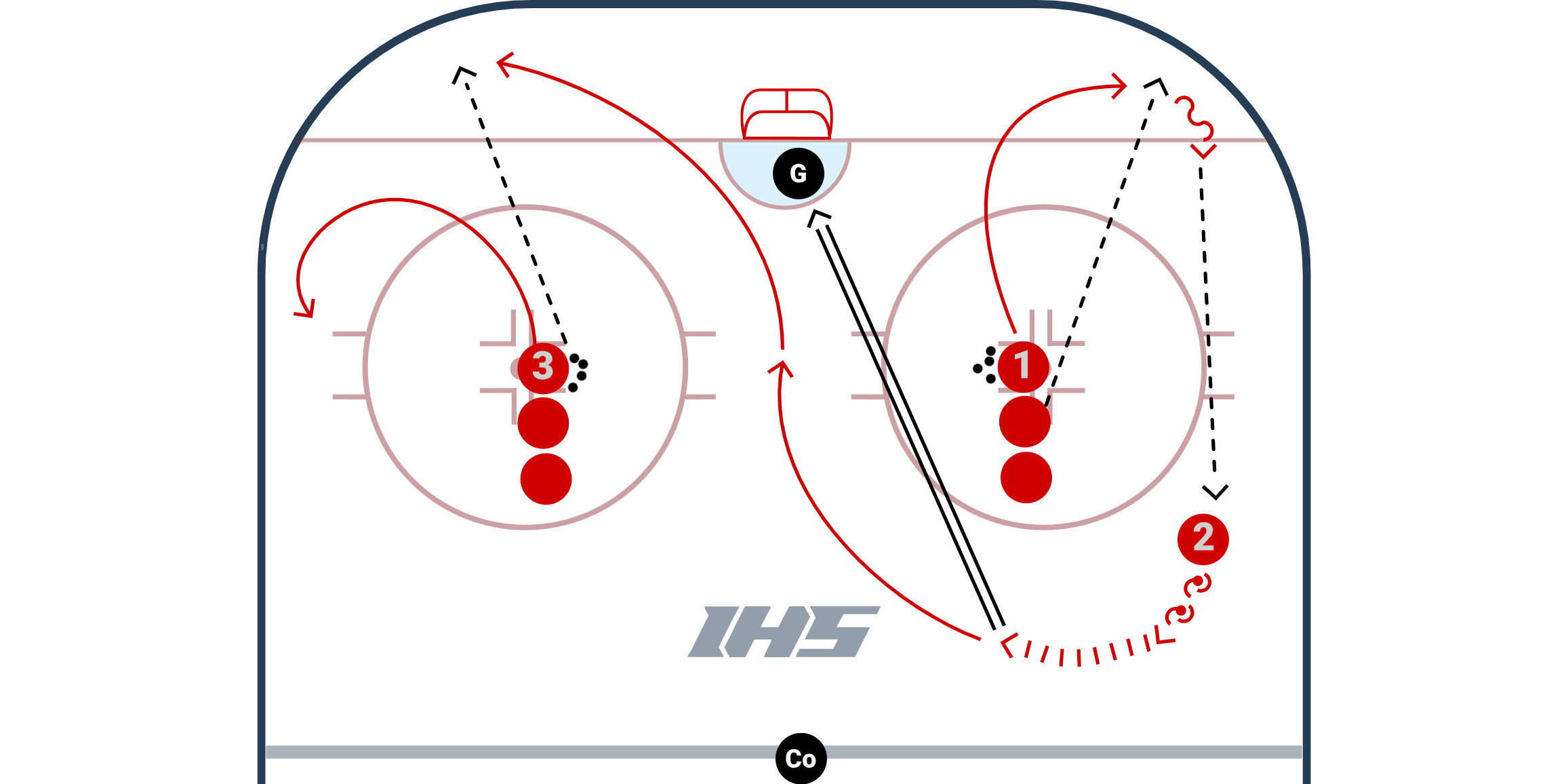
only do progression #1
Wall Retrieval Station
The goal of this drill is to get players a more comfortable handing pucks along the wall and provides a situation you can use to teach them various techniques.
Setup:
- This station can be set up to use half of one of the zones.
- Pucks should be set behind the goal crease in the middle of the ice with the coach or other player. If you are using both sides then two coaches can share the pucks and each will rim the puck to opposite sides.
- A tire or cone can be placed inline with the dots at around the top of the circles.
- Players are lined up along the blue line with the first player inline with the dots.
- Player 1 will skate up around the tire towards the wall, open up to face the puck as it is rimmed around. The players should time it so they are skating up ice as they gather the puck.
- Once they gather the puck they will make a pass to the next player in line, go around the tire, open up and call for the puck, then receive the puck back to take a shot on net.
Coaching Points:
- Encourage players to move their feet and keep their heads up as they gather the puck along the boards.
- Players should look at the point to see where the defense is. You can do this with no defence just to get them in the habit of looking at the point, or you can have the defence add pressure so the drill can be variable.
- Players should get to the wall.
- After they get the puck, they should skate away from the wall so they have space to play to the center or to the boards.
Variations:
- You can add a defender playing the point that occasionally jumps in, which will require the forwards to be more aware of the situation.
- You can add obstacles that the player needs to pass through when they pass to the point.
- You can require the player to shoot in stride, change their shot angle or practice their one-timer when they are shooting on net.
- You can make this drill half ice so more skating and longer passes are required.
- You can have the forward go to the net and have the defense take a shot so the forward has to tip or deflect it.
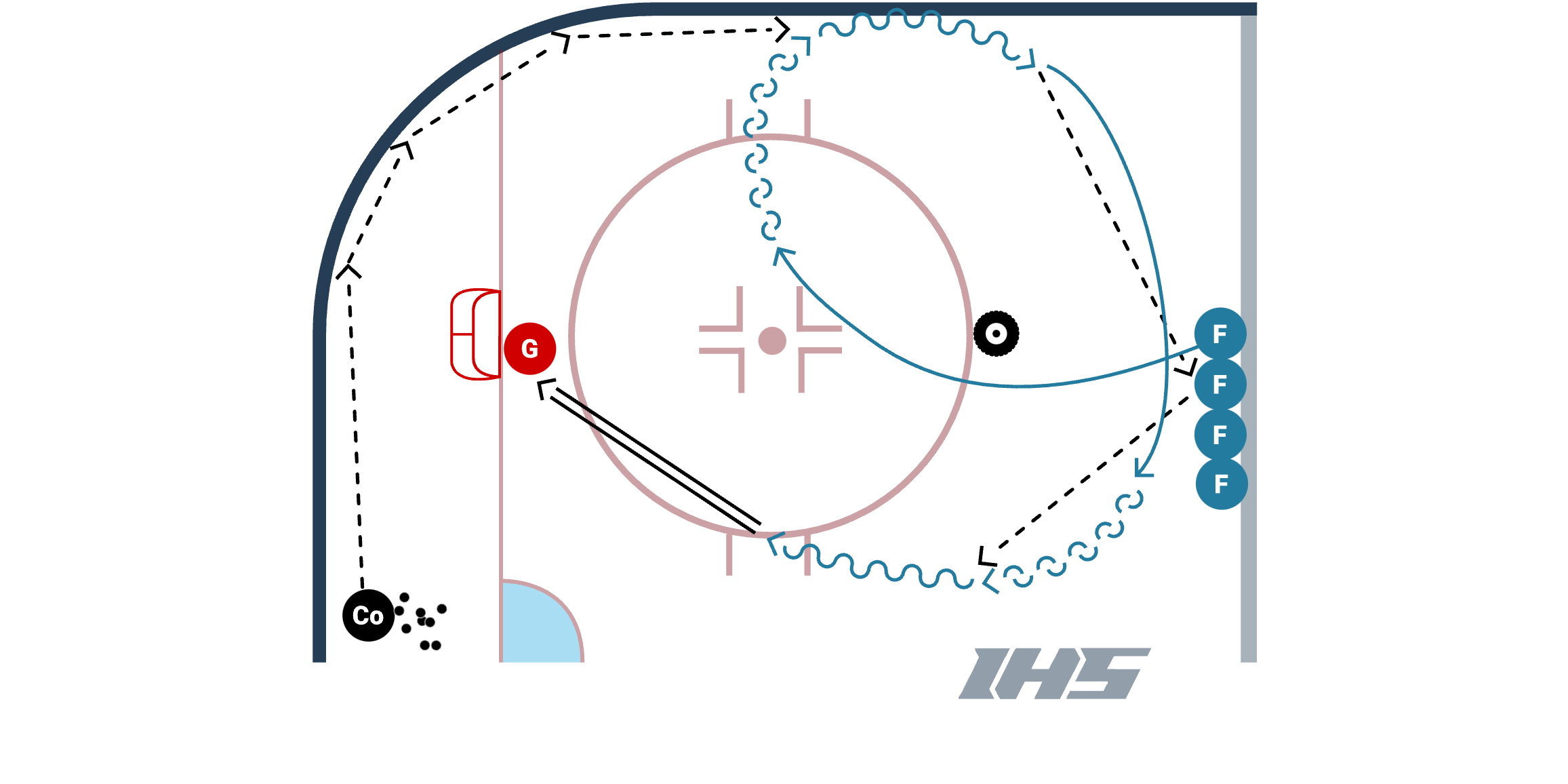
Eagles Half Ice 2 on 1
This is a variation of the Eagles half ice 1 on 1 drill. Now we add a forward to make it a 2 on 1. The forwards all line up in the corner without pucks. The defense line up just inside the forwards with the pucks as shown in the diagram. To start the drill F1 skates up along the boards and receives a pass from D1. F1 receives the pass, skates around the circle and takes a shot on net. F1 then continues around the circle. F2 follows F1 out of the corner and also receives a pass from D1 out of the corner. After their shot, F2 tranisions around the bottom of the other circle to receive a breakout pass from D1. F1 times their break into the slot to receive a pass from F2. F1 and F2 then continue outside the blue line and transition back against D1 in a 2 on 1 situation.
Suggested Drill Lists
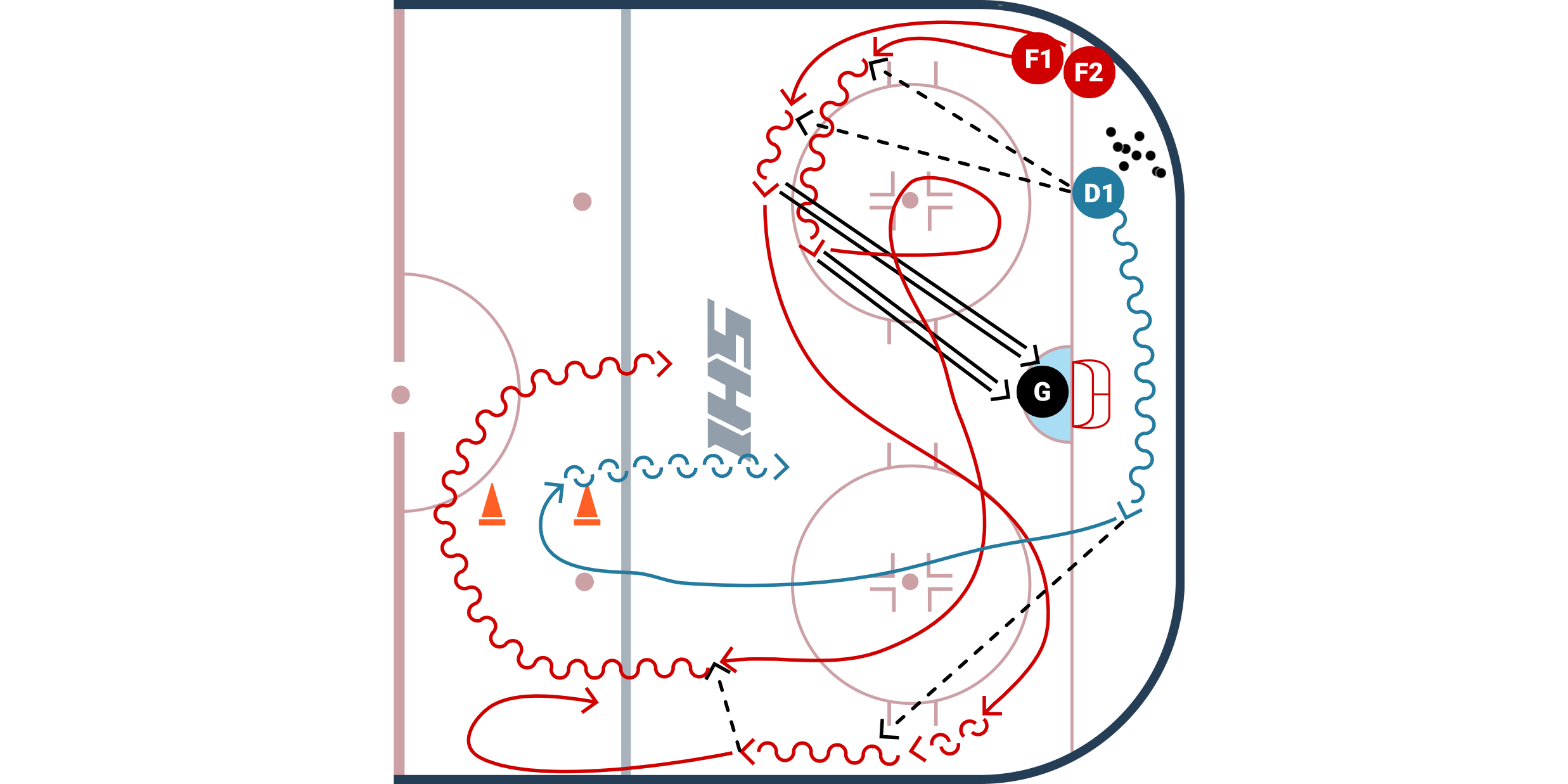
Bourque 3 on 3 Game
The Bourque 3 on 3 cross ice game is similar to the Gretzky Game but now the designated passers behind the nets are referred to as "Bourque." The "Bourque" is behind their own goal line and helps to initiate breakout passes to their teammates. It is important that players regroup to support their "Bourque."
Game Rules
- Players must use their "Bourque" on a change of possession before making an attempt to score.
- Players may attack the other team's "Bourque" but they may not shadow them.
- Players that are playing in the 3 on 3 can go behind their own goal line to help out their own "Bourque".
- There is no limit to how often a team uses their "Bourque."
- Shifts should be 30 - 40 seconds to keep a good pace and high intensity.
- If a puck goes out of play, the coach can dump in a new one.
Coaching Points
- Have the "Bourque" work on a good first pass.
- Use "false Information / deception" (fakes & looking off the pass) to get their players open.
- Players need to skate back to support their "Bourque."
- Fill three lanes and skate to open ice.
Variations:
- Can be 3 on 3 or 2 on 2.
- Can have 2 Bourque's to allow for D to D passes before the breakout starts.
Related Content:
Puck Retrieval Along The Boards
Retrieving the puck along the boards happens countless times throughout the course of the game and it is where many 1 on 1 battles are won or lost. When players collect the puck off of the boards is not usually a highlight-reel play, but if they are able to learn a few simple concepts, they will be able to impact the flow of the game. These concepts will allow players to create space so they have time to make a play. Plus, with an evasive move, they will be much harder to hit!
In the video above, Coach Ben Eaves discusses two major concepts when retrieving a puck:
- Look Over Your Shoulder: This is concept # 1 because it is most important. Looking over your shoulder will allow you to know if you have time, or need to make an evasive move to create time.
- Retrieve The Puck At An Angle: This will allow you to keep your speed up while you are going to get the puck. Plus it is much safer than going head-on into the boards.
The video gives you three options to practice:
- Option 1: If you look over your shoulder and see you have time, continue skating full speed at an angle to pick up the puck and bring it up ice.
- Option 2: If you look over your shoulder and you see you have pressure, skate at an angle but use your upper body to deceive the defending team and quickly turn up ice.
- Option 3: If you look over your shoulder and you see someone right on you, point your feet (which will point your body) one way and quickly move your hips and move your feet in the opposite direction to evade the defender. This is usually the most effective but will take time and good edgework to get comfortable with. Note: When you get comfortable with Option 3, combine the lower body fakes with upper body fakes to really throw off a defender!
Bonus: Watch the Toronto Maple Leafs practice their puck retrievals and forchecking in this fun 1 on 1 battle.
Breakout Tips for Centers
One of the hardest things to teach centers on the breakout is the timing. It is critical that the centers have a good sense of timing so they can support the defense and wingers when they have the puck. If they get too far ahead of the play they create a bad angle for a pass and put themselves in a bad position to receive a pass. By staying low and below the puck then they give their teammates better options.
Tips for the Centers on Breakouts
- Stay low and slow.
- Support your defense and wingers.
- Be ready to skate into the puck.
- Communicate with your defense and wingers.
Breakout Tips (Strong Side Wingers)
Here are some breakout tips for wingers on their strong side when the puck is rimmed along the wall. There are three situations listed below but on all situations the wingers should do the following three things:
- look up ice to see what the defense is doing.
- get to the wall before the puck gets to your spot.
- get separation from the wall so you have more options.
Option #1 - No Pressure
- Skate with direction of the puck.
- Let puck come to you as you are headed up ice.
- Get separation from the wall.
Option #2 - Hard Pressure
- Stop the puck with backhand.
- Protect puck with body.
- Get separation from the wall.
- Chip high off the glass.
Option #3 - Hard Pressure
- Get to the wall and stop puck with skates.
- Angle skates to get puck off wall and to your stick.
- Protect puck with body if needed.
- Get separation off of the wall.
- Use forehand to chip puck high off the glass.
Breakout Tips (Off-Hand Wingers)
Here are a few options for wingers on their off-hand (weak) side when the puck is rimmed around the wall. First and foremost you always want to check what the opposing defense is doing. Are they allowing you time and space to gather the puck or are they applying pressure?
Option #1
- Get to the wall and gather puck at the wall.
- Use forehand to collect the puck faceing your own net.
- Get off the wall and look to make a play to the center or high off the wall and out of the zone.
Option #2 - No Pressure from Defense
- Get to the wall and face up ice skating with the direction of the rimmed puck.
- Once you collect puck get head up and try ot get off the wall as you head up ice.
Option #3 - Heavy Pressure
- Get to the wall and trap puck using skates.
- Use your body to protect the puck from the defense.
- If possible use the angle of your skates to get puck off the wall.
- Once off the wall look to make a play or chip the puck into the neutral zone.
Additional Breakout Resources
View our U16+ Breakout Practice
- Puck Retrieval Along the boards
- Breakout Tips (strong side winger)
- Breakout Tips (off-hand wingers)
- Breakout Tips for Centers
IHS Members can create their own practice plans that look like this. Learn how here
